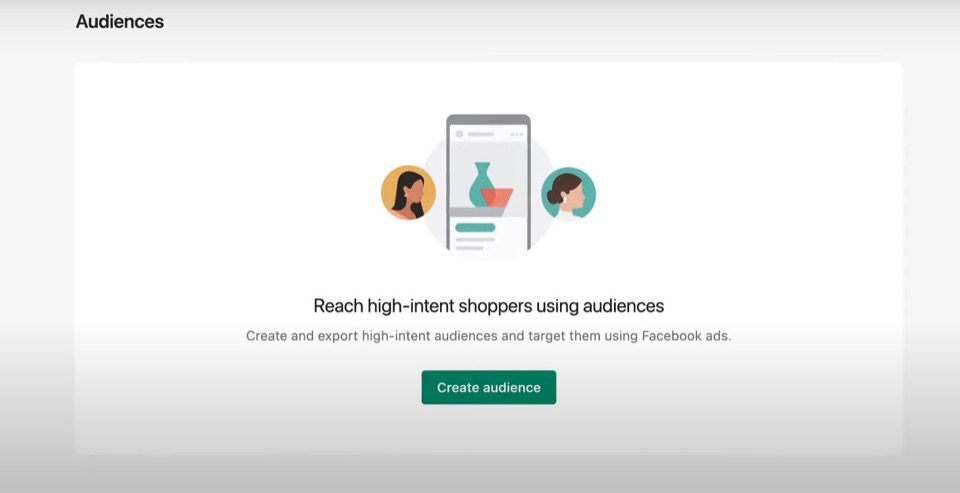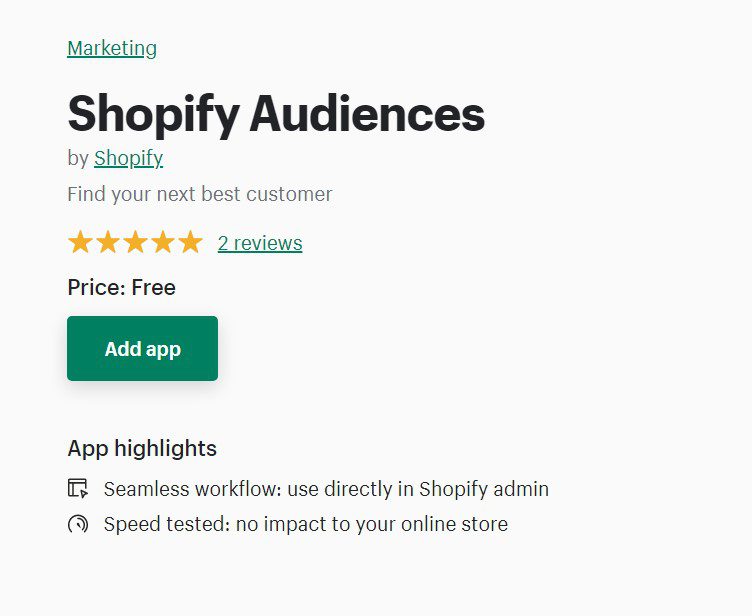
Growing competition has made the ecommerce market increasingly difficult to navigate. Low-quality traffic, decreasing ROI on ad spend, and abysmal conversion rates are just a few of the many challenges businesses encounter on a daily basis. Thankfully, technology is keeping up with the evolving market, and Shopify’s new Audiences tool may be the solution your business has been waiting for.
Audiences is a new machine learning-powered feature that alleviates some of the pain points most ecommerce businesses face. Shopify Plus merchants can use Audiences to find high-intent buyers with a new, customized approach to targeting. Audiences completely changes the way we look at ROI and customer attribution.
Table of Contents
How Does Shopify Audiences Work?
Let’s say you’re a Shopify merchant looking for a new way to acquire customers. Sales might’ve been great at first, but ad spend can quickly catch up with you when you’re trying to scale and reach new customer segments.
Audiences is the perfect tool for this scenario. Once you’ve consented to share merchant data with Shopify, the tool will create lists of potential buyers, known as audiences, for a product of your choice. These lists can then be exported to platforms like Facebook and Instagram for targeted ad campaigns.
The Audiences Advantage
Audiences’ unique approach to top-of-funnel advertising excels due to the customization Shopify brings to the table. This is partly enabled by the massive number of merchants who already use the platform to scale. Leveraging the network created by Audiences opens new doors for Shopify Plus merchants, such as:
Measuring Intent
The new feature’s foundation is a highly accurate system that matches buyer intent with product attributes. The Shopify Audiences tool saves businesses the time-consuming and expensive process of increasing conversion rates with trial-and-error. Why spend precious resources guessing where your buyers are if you can just find them with the click of a button?
Case studies published by Shopify confirm Audiences’ impressive potential for ecommerce growth. Early adopters reported notable improvements to their marketing processes, including:
- A significant increase in ROI on ad spend
- Simplified customer targeting
- Easier performance tracking using Shopify’s in-built analytics platforms
Easier Targeting
Customer acquisition costs have increased across the board, with Meta ads becoming 61% more expensive over 2021. Audiences is a clever solution to a crucial obstacle between your business and long-term growth.
Machine learning (ML) is the key to lowering customer acquisition costs with Shopify’s Audiences tool, where large quantities of buyer data are processed to create actionable insight for businesses. ML allows Shopify Audiences to observe buyer trends on a broader scale and pinpoint likely customers with an accuracy that’s difficult to replicate manually with analytics. Similar to YouTube’s targeting algorithm for videos, Shopify understands that a one-size-fits-all approach doesn’t suit ecommerce.
Unique Attribution
An attribution model refers to the framework used by businesses to determine which touchpoints should be credited for a conversion. It’s the era of omnichannel marketing, and merchants are quickly adapting to customers that hop between multiple channels before making a purchase.
Tracking your customer’s journey in such an environment is difficult, and if you can’t track, you can’t improve.
Shopify Audiences’ customization is complemented by a unique attribution model that simplifies touchpoint tracking and cuts down on ambiguity around conversions. This means that as a business, you can tell exactly which conversions have been powered by Audiences, with a high degree of confidence.
This exclusive model is made possible in part by Shopify’s ability to measure performance through emails, not just at the checkout stage, but also before it. Shopify’s Audiences tool will match the checkout email with customers in your audience to assign credit once the order has been processed.
Detailed Reporting
Shopify Audiences includes a powerful reporting tool to help you track the progress of your customized campaigns. Audiences includes two types of reports: overview and detailed.
- Overview: These reports only track total orders and sales, and serve as a snapshot of the value that Audiences’ has generated for your business.
- Detailed: Tracks detailed metrics for each of your audiences, such as average order value, sales, orders, new customers, and your best-performing products. These reports also include information on audience overlaps. If an order was placed by a shopper that is in multiple audiences, then the order will be divided between each audience.
Merchants can track Shopify Audiences’ performance at every step with a reporting tool that lets nothing slip through the cracks.
Transparent and Private
Merchant and buyer privacy are both prioritized here. Buyer data can only be accessed with the merchant’s consent and is hashed to maximize security. Businesses won’t have access to personal buyer information or statistics, and this data is securely encrypted during transmission to ad platforms.
Consent, combined with Shopify’s transparent approach to attribution and compliance with evolving privacy laws strengthens Audiences’ position as a tool that merchants should not miss out on. If you’d like to opt out of sharing data, you can do so at any point.
Growing With Audiences
Getting started with Audiences is easy, the streamlined installation process takes minutes to complete. Let’s briefly go through the steps involved, including how you can make the most of Shopify’s exciting new feature.
Opt-In!
You must be a Shopify Plus merchant in the US or Canada to be considered eligible for Audiences. Verify your eligibility and install the Audiences app to proceed. You’ll have to set up the app before you can create your first audience.

Navigate to the ‘Apps and sales channels’ page in your settings menu and open the Audiences app. Once you’ve selected ‘Set up audiences’, you’ll be prompted to enable data contribution and accept Shopify Audiences’ terms to use the tool. Keep in mind that by accepting, you’ll automatically be sharing customer data for audience creation. We recommend updating your site’s privacy policy to outline your use of Audiences, disclosure of personal data, and the buyers’ ability to opt out at any point for compliance.
After accepting, hit ‘Set up’ to link your Facebook account for ad campaigns. Once you’ve accepted Facebook’s Audiences terms, you’ll be ready to create your first audience with Shopify.
Creating an Audience
Shopify creates your customized audiences by using the selected product’s attributes. Begin by selecting the ‘Create audience’ option in the Audiences app. You’ll be able to view all your products here and select the one you’d like to create an audience for. Choose a name for the audience and click the ‘Export Audience’ option to proceed.
It’s worth noting that there is a limit to the number of audiences you can create in a week with Shopify’s tool. This limit will be displayed on the Shopify dashboard after you’ve exported an audience for the first time. Additionally, only buyers in the US and Canada will be considered for audience lists, and buyers that have already opted out will also be excluded.
Remember that your audience list won’t be actively updated once it’s been exported to an ad platform. If your store has experienced a surge in buyers after a campaign, you’ll have to create and export a new audience to include them.
Best Practices for Shopify Audiences
Shopify Audiences brings an incredible degree of customization and reporting to the table, but making the most of it will still require a fair bit of creativity on the merchant’s part.
- Selecting Products: Shopify’s first-party data is an invaluable resource, and businesses have to be strategic with their product choices, especially considering Shopify’s weekly limitations. If you already have a product performing decently, it might be worth creating an audience for a less popular offering. Shopify’s Audiences tool can help you find a niche community and multiply your sales with a well-placed ad campaign.
- If you’re working with limited resources, consider bringing down your ad spend on other, more unproductive channels as you discover high-intent buyer groups with Shopify Audiences.
- Avoid Overlap: Limit your audiences to 1 per ad set to avoid overlap. Attribution overlap can make it difficult for merchants to identify the individual channels that are driving their sales.
- Move Fast: An audience won’t account for any new buyers once it has been exported. This means that waiting too long to export an audience can negatively impact the accuracy of your ad campaigns. Make the most of Shopify Audiences’ customized data sets by running your campaigns right after the export.
- A/B Testing: Closely tracking ecommerce metrics isn’t the only way to grow with analytics. Bing reported a 25% increase in ad revenue from using A/B testing, and Shopify Audiences takes that potential to the next level. Shopify merchants can use the Audiences tool to fine-tune their marketing strategy with A/B testing for highly specific customer segments.
For example, you can show two different sets of ads to your target audience and learn more about what drives sales for a demographic that is most likely already interested in your product. This presents a unique opportunity for businesses to test subtle differences in ads and determine a winning strategy.
Shopify merchants running customized A/B tests on Meta platforms with Audiences should consider these points before creating a comparison:- You’ll want to include only those buyers located in the US and Canada, as shoppers from other geographic regions will not be included in your Shopify Audiences lists (for now!)
- Don’t forget the budget! Audience lists can vary in size depending on the attributes of a product. If you’re comparing campaigns for two different products, ensure that you’re also adjusting the budget accordingly. A larger audience would generally call for a bigger budget.
Last but definitely not least – be transparent! Shopify Audiences is an exciting tool for growth, but its incredible features are only made possible by consenting shoppers. Once lost, customer loyalty is incredibly difficult, if not impossible, to regain.
Let buyers—past or present—know about their data privacy rights and your own Shopify Audiences policies with an easily visible disclaimer on your website. Your existing shoppers will respect you for it, and you’ll also establish trust with your future customers.
What To Look Out For
As promising as it is, Shopify Audiences is still a new tool, and that comes with its own set of limitations.
- Region and Platform Limitations: Audiences is currently limited to Plus merchants in the US and Canada and Meta platforms. Considering a significant 17% of merchants are located in Europe alone, it’s fair to assume that Shopify will be rolling their new Audiences feature out to other countries and platforms like TikTok over the coming months. Businesses that start prepping now can benefit immensely from an early mover advantage.
- A Substitute For Analytics: Audiences’ robust algorithm shouldn’t be treated as a substitute for analytics platforms. Instead, a better approach would be to complement Shopify’s customized audiences with a dedicated analytics platform like Google Analytics 4 (GA4). You can further improve attribution with GA4 by creating customized goals and tracking each step of the customer’s journey.
- Excludes Existing Customers: As a tool, Shopify Audiences is designed around new customer acquisition. This means you cannot create a buyer list for your existing customers.
Data That Delivers Results
Unlock the power of first-party data. Use Audiences to tap into Shopify’s extensive network of merchants and high-intent buyers, and boost your ROI the smart way. Learn more about growing with a customized strategy by following Coalition Technologies, an industry leader in digital marketing.


